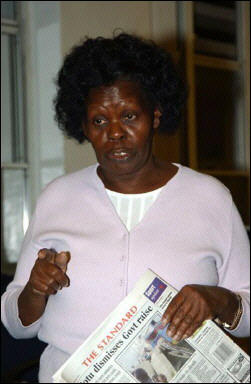
Once Kivuitu walks into the plenary hall of KICC at 4:37 pm on Sunday, December 30th, to announce the rigged results, the stage is set for a a civilian coup. The GSU storms the plenary hall and ejects Opposition MPs, agents and the media from the hall. Outside, more GSU and Administration Police surround the building and clear the compound. A lone Nation reporter is still filming the unfolding drama. He captures the arrival of the Police Commissioner's car.
However, the Police Commissioner is already inside the building, having walked from Vigilance House. He walks to his car, past an armed GSU guard. Most of them seem unsure of what to do. Only a few salute. Maj. Gen. Ali's car follows behind that of Justice Minister, Martha Karua who had made a quick arrival and departure. Minutes later, Kivuitu declares Mwai Kibaki the winner of the election. Only the state-owned KBC is allowed to broadcast the declaration. KBC swiftly transmits the material to all other media houses. About an hour later, Mwai Kibaki is sworn in at State House by the Chief Justice Evan Gicheru in the presence of the Attorney General, Amos Wako, his key aides, supporters and military chiefs and Maj. Gen. Ali. Within minutes, ten people are killed in Kisii.
Later that evening, John Michuki, Minister of Internal Security, through Bitange Ndemo, the PS Ministry of Information, issues a circular banning all live broadcasts "in the interest of public security and good order. Two days later, Samuel Kivuitu admits that he does not know whether or not Mwai Kibaki won the general election.
NB -- ATTORNEY GENERAL AMOS WAKO WAS ONE OF THE COUP MAKERS. YET LATER THAT DAY, HE WAS ASKING FOR AN INQUIRY.
The Facts of the post-election violence are these:
• More than 1,327 people were killed due to the violence (estimate based on continuous recordings) - many by armed government forces with shoot-to-kill orders and ethnic killings with crude weapons. Official police count: 526 killed (police only admited so far 90 killings caused by security forces); official government count 923. Unofficial police statement on 25th February 2008 (given by an unnamed Senior Police Commander to AFP): 1,500. Most media count over 1000 killings. UN estimate: 921 killings; Red Cross estimate: More than 1000. Opposition estimate: More than 1,500. Overall 57% were killed by crude weapons or burns and 43% by bullets. However, in Western Province 91% were killed by bullets. Mortuaries were overfilled everywhere. Bodies were dumped in forests. Government banned mass graves for uncollected bodies. Numerous people abducted by "police" still not found.
• More than 550 private motor vehicles and more than 280 Public Service vehicles were burned.
• More than 1,850 women and girls raped and many forcefully circumcised (also many men and boys are circumcised by force). Though the turmoil calmed down more than 165 underaged children even young as only 2 years of age are at present defiled per month, says official police report. And these are only the reported cases.
• More than 5,685 houses, shops and increasing number of schools, public buildings and churches burnt down.
• More than 12,500 Kenyans fled into Uganda and over 3,000 to Tanzania. Only very few returned. On 6th March 2008, UNHCR counted 12,000 refugees from Kenya in Uganda.
• More than 6,850 children seriously injured (many by police and other armed forces).
• More than 14,689 adults seriously injured or wounded (many by security forces).
• More than 23,800 people robbed of all their property.
• More than 80,000 school children, who had to flee, had to be allocated to other schools, while 520 school teachers could not return to their schools for fear of ethnic persecution. Allocations were stopped due to renewed tension.
• More than 100,000 children were registered as displaced (UNICEF), another 100,000 not accounted for at their former residences, i.e. they fled with or without their families and nobody knows where they are.
• More than 600,000 people fled from their homes (Government counted only 219,485) and about 50% (ICRC: 304,000, UN: 310,000) were registered as IDPs (internally displaced people, i.e., refugees in their own country) in more than 44 "official" IDP-camps all over the country, but in reality at many more sites (UN: More then 300 camps - over 192 sites in western and central regions alone). In the North Rift Valley alone over 126,000 people were displaced. Many IDPs were and are still unreached and without shelter or food. About 150,000 registered IDPs have left the camps for their ancestral homelands. Around 300,000 people found refuge with families and friends as well as other wellwishing Kenyans and expatriates. Beginning of March still 200,000 people (some newly registered) are in protected camps.
All this because Kibaki wanted to go back to State House. It's so surreal, I still feel like I'm dreaming...



Comments